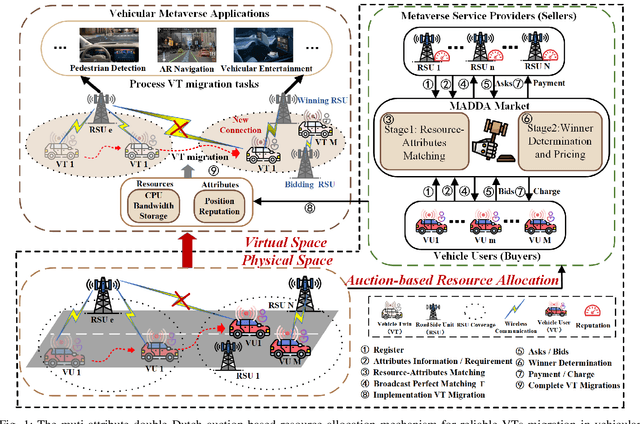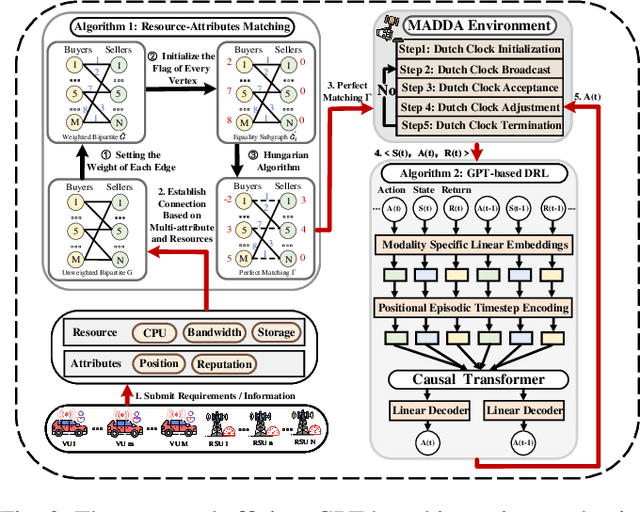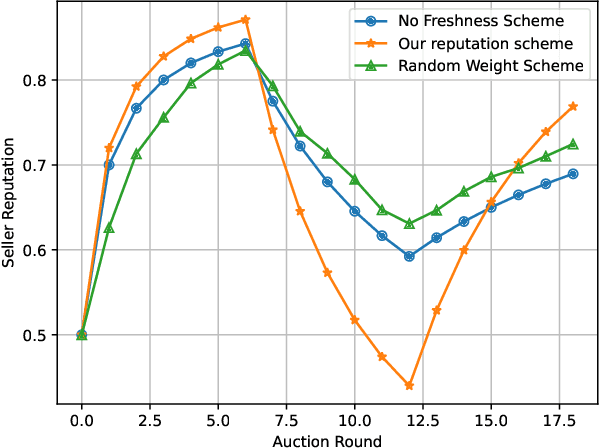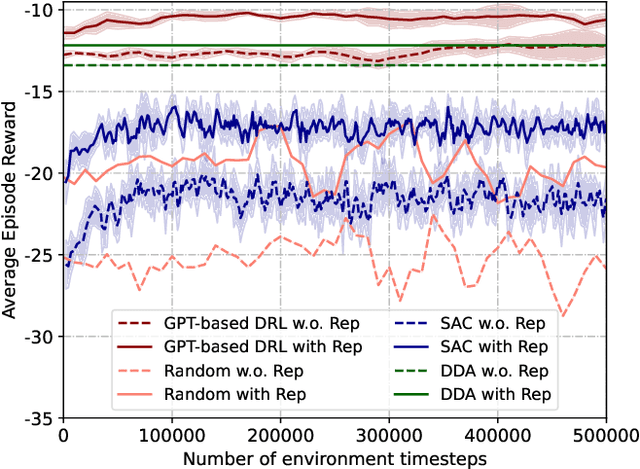Yongju Tong
Diffusion-based Auction Mechanism for Efficient Resource Management in 6G-enabled Vehicular Metaverses
Nov 01, 2024Abstract:The rise of 6G-enable Vehicular Metaverses is transforming the automotive industry by integrating immersive, real-time vehicular services through ultra-low latency and high bandwidth connectivity. In 6G-enable Vehicular Metaverses, vehicles are represented by Vehicle Twins (VTs), which serve as digital replicas of physical vehicles to support real-time vehicular applications such as large Artificial Intelligence (AI) model-based Augmented Reality (AR) navigation, called VT tasks. VT tasks are resource-intensive and need to be offloaded to ground Base Stations (BSs) for fast processing. However, high demand for VT tasks and limited resources of ground BSs, pose significant resource allocation challenges, particularly in densely populated urban areas like intersections. As a promising solution, Unmanned Aerial Vehicles (UAVs) act as aerial edge servers to dynamically assist ground BSs in handling VT tasks, relieving resource pressure on ground BSs. However, due to high mobility of UAVs, there exists information asymmetry regarding VT task demands between UAVs and ground BSs, resulting in inefficient resource allocation of UAVs. To address these challenges, we propose a learning-based Modified Second-Bid (MSB) auction mechanism to optimize resource allocation between ground BSs and UAVs by accounting for VT task latency and accuracy. Moreover, we design a diffusion-based reinforcement learning algorithm to optimize the price scaling factor, maximizing the total surplus of resource providers and minimizing VT task latency. Finally, simulation results demonstrate that the proposed diffusion-based MSB auction outperforms traditional baselines, providing better resource distribution and enhanced service quality for vehicular users.
Multi-attribute Auction-based Resource Allocation for Twins Migration in Vehicular Metaverses: A GPT-based DRL Approach
Jun 08, 2024



Abstract:Vehicular Metaverses are developed to enhance the modern automotive industry with an immersive and safe experience among connected vehicles and roadside infrastructures, e.g., RoadSide Units (RSUs). For seamless synchronization with virtual spaces, Vehicle Twins (VTs) are constructed as digital representations of physical entities. However, resource-intensive VTs updating and high mobility of vehicles require intensive computation, communication, and storage resources, especially for their migration among RSUs with limited coverages. To address these issues, we propose an attribute-aware auction-based mechanism to optimize resource allocation during VTs migration by considering both price and non-monetary attributes, e.g., location and reputation. In this mechanism, we propose a two-stage matching for vehicular users and Metaverse service providers in multi-attribute resource markets. First, the resource attributes matching algorithm obtains the resource attributes perfect matching, namely, buyers and sellers can participate in a double Dutch auction (DDA). Then, we train a DDA auctioneer using a generative pre-trained transformer (GPT)-based deep reinforcement learning (DRL) algorithm to adjust the auction clocks efficiently during the auction process. We compare the performance of social welfare and auction information exchange costs with state-of-the-art baselines under different settings. Simulation results show that our proposed GPT-based DRL auction schemes have better performance than others.
Diffusion-based Reinforcement Learning for Dynamic UAV-assisted Vehicle Twins Migration in Vehicular Metaverses
Jun 08, 2024Abstract:Air-ground integrated networks can relieve communication pressure on ground transportation networks and provide 6G-enabled vehicular Metaverses services offloading in remote areas with sparse RoadSide Units (RSUs) coverage and downtown areas where users have a high demand for vehicular services. Vehicle Twins (VTs) are the digital twins of physical vehicles to enable more immersive and realistic vehicular services, which can be offloaded and updated on RSU, to manage and provide vehicular Metaverses services to passengers and drivers. The high mobility of vehicles and the limited coverage of RSU signals necessitate VT migration to ensure service continuity when vehicles leave the signal coverage of RSUs. However, uneven VT task migration might overload some RSUs, which might result in increased service latency, and thus impactive immersive experiences for users. In this paper, we propose a dynamic Unmanned Aerial Vehicle (UAV)-assisted VT migration framework in air-ground integrated networks, where UAVs act as aerial edge servers to assist ground RSUs during VT task offloading. In this framework, we propose a diffusion-based Reinforcement Learning (RL) algorithm, which can efficiently make immersive VT migration decisions in UAV-assisted vehicular networks. To balance the workload of RSUs and improve VT migration quality, we design a novel dynamic path planning algorithm based on a heuristic search strategy for UAVs. Simulation results show that the diffusion-based RL algorithm with UAV-assisted performs better than other baseline schemes.
 Add to Chrome
Add to Chrome Add to Firefox
Add to Firefox Add to Edge
Add to Edge